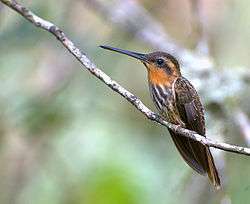Saw-billed hermit
| Saw-billed hermit | |
|---|---|
 | |
| Scientific classification | |
| Kingdom: | Animalia |
| Phylum: | Chordata |
| Class: | Aves |
| Order: | Apodiformes |
| Family: | Trochilidae |
| Subfamily: | Phaethornithinae |
| Genus: | Ramphodon Lesson, 1830 |
| Species: | R. naevius |
| Binomial name | |
| Ramphodon naevius (Dumont, 1818) | |
| Synonyms | |
|
Trochilus naevius Dumont, 1818 | |
The saw-billed hermit (Ramphodon naevius) is a hummingbird from southeastern Brazil, the only member of the genus Ramphodon. It is around 14–16 cm long and is one of the heaviest of the hermits; its straight bill has a hooked tip. It lives in humid forests, where it aggressively defends feeding routes ("trap-lines") from individuals of its own species as well as other hummingbirds. It is currently considered near-threatened, since it has a restricted range in threatened Atlantic forests.
The saw-billed hermit is placed in the hermit subfamily Phaethornithinae, but among these birds, it is the species most similar to the typical hummingbirds, Trochilinae (Hinkelmann, 1999). This, coupled with the considerable number of autapomorphies such as the unusual bill, suggest it is the most primitive species of the hermit lineage; a situation paralleled by the equally unusual tooth-billed hummingbird in the Trochilinae.

References
- ↑ BirdLife International (2012). "Ramphodon naevius". IUCN Red List of Threatened Species. Version 2013.2. International Union for Conservation of Nature. Retrieved 26 November 2013.
- Hinkelmann, C. (1999): 1. Saw-billed Hermit. In: del Hoyo, J.; Elliott, A. & Sargatal, J. (editors) (1999): Handbook of Birds of the World, Volume 5: Barn-owls to Hummingbirds: 537, plate 45. Lynx Edicions, Barcelona. ISBN 84-87334-25-3
External links
- BirdLife Species Factsheet
- Saw-billed Hermit photo gallery VIREO Photo-High Res-(Close-up)
- Saw-billed Hermit videos on the Internet Bird Collection
